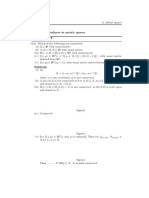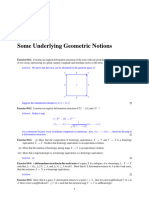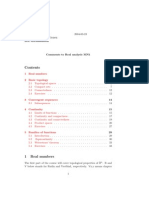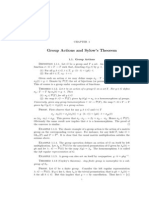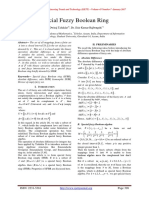Math 142, Spring 2013. HW2 Solutions: A F F Closed in X
Math 142, Spring 2013. HW2 Solutions: A F F Closed in X
Uploaded by
Patricia Calvo PérezCopyright:
Available Formats
Math 142, Spring 2013. HW2 Solutions: A F F Closed in X
Math 142, Spring 2013. HW2 Solutions: A F F Closed in X
Uploaded by
Patricia Calvo PérezOriginal Title
Copyright
Available Formats
Share this document
Did you find this document useful?
Is this content inappropriate?
Copyright:
Available Formats
Math 142, Spring 2013. HW2 Solutions: A F F Closed in X
Math 142, Spring 2013. HW2 Solutions: A F F Closed in X
Uploaded by
Patricia Calvo PérezCopyright:
Available Formats
Math 142, Spring 2013.
HW2 Solutions
3. a) Let A X , with X a topological space. Then, A is the intersection of every closed set that contains A, A= F
A F F closed in X
Thus, as this is an arbitrary intersection of closed sets it must be a closed set (by the dening properties of a topology). b) We will show that A is contained in every other closed set that contains A: let F A be closed. Then, F appears in in the above intersection as an intersectand (?). As F F = A,
F A F closed
and F was an arbitrary closed set in X containing A, the result follows. c) Suppose that A is closed. Then, as A A we see that A appears as an intersectand in the above denition of A. Also, note that an intersection of sets containing A must itself contain A: indeed, if Ci X , for i I with I some indexing set, and Ci A, for every i I , then a A = a Ci , for each i I . Hence, a A = a i Ci . Hence, we have AA= F A = A = A.
A F F closed
Now assume that A = A. We have seen in a) that A is closed in X , so that A = A must be closed in X also. 5. The diagonal map is the map : X X X ; x (x , x ). Lets denote = (X ), by abuse of notation. Suppose that X is Hausdor: this means that for any x1 = x2 X , we can nd U1 , U2 X open, such that U1 x1 , U2 x2 and U1 U2 = . To show that X X is closed it suces to show that X X is open. Let (x1 , x2 ) X X , so that x1 = x2 (think of the denition of ). Let U1 x1 , U2 x2 be open sets in X as above. Then, (x1 , x2 ) U1 U2 , with U1 U2 is (a basic) open set in X X . Moreover, suppose that (y , y ) U1 U2 , for some y X . Then, y U1 and y U2 so that y U1 U2 = , which is absurd. Hence, (U1 U2 ) = , so that (x1 , x2 ) is an interior point of X X . As (x1 , x2 ) was arbitrary we have that X X is open in X X , so that is closed in X X . Suppose that is closed in X X . Thus, X X is open in X X . Let x1 = x2 X . Then, (x1 , x2 ) / so that we can nd a (basic) open set U1 U2 X X with (x1 , x2 ) U1 U2 . Hence, x1 U1 and x2 U2 . Moreover, suppose that y U1 U2 . Then, (y , y ) U1 U2 and (U1 U2 ) = , which is absurd. Hence, U1 U2 = and, as x1 , x2 were arbitrary, distinct elements of X , we have that X is Hausdor. 9. A ridiculously straightforward example is X = {}, a one point set. Then, X X = {(, )} is also a one point set. There is precisely one topology on a one point set, the trivial topology, 1
and there exists exactly one function between any pair of one point sets (in fact, there is exactly one function from any set to a one point set); namely f : X X X ; (, ) . Hence, f must necessarily be a homeomorphism as it is obviously bijective, with inverse g : X X X ; (, ), and each of these functions is continuous with respect to the trivial topology on X , X X . Note: this is the only example to take with X nite and nonempty: if > |X | > 1 then |X X | = |X |2 > |X |, and so there cannot exist a bijective function (therefore, denitely not a bicontinuous function) between X and X X . For countably innite sets X we can nd a bijection f : X X X - use the same counting argument that is used to show that Q is countable - and if we take the trivial topology on X then the product topology on X X is the trivial topology. Then, the bijection f is bicontinuous. For arbitrary innite sets we use the following fact: if X is innite, then X X and X have the same cardinality; although this may not be well-known. This means that we can nd a bijection between X X and X and, using the trivial topology again, we can assume this bijection is bicontinuous.
You might also like
- Topology - Solutions Sections 51-54Document29 pagesTopology - Solutions Sections 51-54Leonardo Amorim Silva100% (1)
- Exercicios MunkresDocument22 pagesExercicios MunkresPaulo Apipe100% (1)
- Cartan Structure EquationsDocument6 pagesCartan Structure EquationsSumanto Chanda100% (4)
- 07 - Product SpacesDocument9 pages07 - Product SpacesBabu JuttNo ratings yet
- Set Theory by SM SrivastavaDocument37 pagesSet Theory by SM SrivastavaRAMJANNo ratings yet
- Locally Compact SpacesDocument9 pagesLocally Compact SpacesImam FauziNo ratings yet
- Mid-Term Exam: Geometry/Topology IDocument3 pagesMid-Term Exam: Geometry/Topology IJuwandaNo ratings yet
- Exercise PDFDocument22 pagesExercise PDFImam Fauzi100% (1)
- Solutions 4 - 640Document3 pagesSolutions 4 - 640Calixto RhenalsNo ratings yet
- Section3 PDFDocument10 pagesSection3 PDFMnjNo ratings yet
- Math 205 Asolutions 3Document19 pagesMath 205 Asolutions 3HANCEL MIRANDA GARCIANo ratings yet
- Compact 1Document9 pagesCompact 1AHALYA ANINo ratings yet
- Hartshorne Algebraic Geometry SolutionsDocument130 pagesHartshorne Algebraic Geometry SolutionsΠΤΟΛΕΜΑΙΟΣ ΗΡΑΚΛΕΙΔΗΣ50% (2)
- Solutions To Problem Set 3: Limits and ClosuresDocument4 pagesSolutions To Problem Set 3: Limits and ClosuresanthalyaNo ratings yet
- Mathematics 121 Final Terence Tao June 10, 1997Document10 pagesMathematics 121 Final Terence Tao June 10, 1997nanndo_00No ratings yet
- Teste1 ResolDocument3 pagesTeste1 ResolEdmilson BarrosNo ratings yet
- H. Class Notes of Topology-I, Semester-I, Unit-I..Document3 pagesH. Class Notes of Topology-I, Semester-I, Unit-I..Sahil SharmaNo ratings yet
- Math 142, Spring 2012. HW1 Solutions: X Y 1 1 1 R 0 R R 0 R 1 1 1 1 1 1Document1 pageMath 142, Spring 2012. HW1 Solutions: X Y 1 1 1 R 0 R R 0 R 1 1 1 1 1 1Patricia Calvo PérezNo ratings yet
- Hartshorne Algebraic Geometry SolutionsDocument130 pagesHartshorne Algebraic Geometry SolutionsFrank WanNo ratings yet
- Clay ShonkwilerDocument10 pagesClay Shonkwilerjohn605No ratings yet
- Rudin 4Document20 pagesRudin 4Cody SageNo ratings yet
- 325 HW 06Document2 pages325 HW 06Hyunjoo Noh100% (1)
- 10 Compactness in Function Spaces: Ascoli-Arzel A TheoremDocument5 pages10 Compactness in Function Spaces: Ascoli-Arzel A TheoremronalduckNo ratings yet
- Chapter 11 SolutionsDocument3 pagesChapter 11 SolutionsAli INo ratings yet
- Algebraic Geometry 2Document7 pagesAlgebraic Geometry 2Arkadev GhoshNo ratings yet
- DIV (Divisores) X - Daniel MurfetDocument24 pagesDIV (Divisores) X - Daniel MurfetGerardo ZubiagaNo ratings yet
- MSM3P22/MSM4P22 Further Complex Variable Theory & General Topology Solutions To Problem Sheet 4Document5 pagesMSM3P22/MSM4P22 Further Complex Variable Theory & General Topology Solutions To Problem Sheet 4Jeoff Libo-onNo ratings yet
- Solutions 3 - 640Document3 pagesSolutions 3 - 640Calixto RhenalsNo ratings yet
- MAT480 Hw8 SolutionDocument4 pagesMAT480 Hw8 SolutionAlejandro GomezNo ratings yet
- Chapter 2. Topological Spaces: Proofs Covered in ClassDocument45 pagesChapter 2. Topological Spaces: Proofs Covered in ClassJeoff Libo-onNo ratings yet
- 01 Top PDFDocument8 pages01 Top PDFAsifNo ratings yet
- Diagonal Points Having Dense OrbitDocument12 pagesDiagonal Points Having Dense Orbitalper26esNo ratings yet
- HW 3 SolDocument5 pagesHW 3 SolJuan David TorresNo ratings yet
- Problem Set 3: Limits and Closures: Your Name: Due: Thursday, February 18Document2 pagesProblem Set 3: Limits and Closures: Your Name: Due: Thursday, February 18anthalyaNo ratings yet
- 8.2. Connectedness in Metric Spaces Problem Set 9Document9 pages8.2. Connectedness in Metric Spaces Problem Set 9Yogesh RanaNo ratings yet
- Alaoglu's TheoremDocument5 pagesAlaoglu's TheoremBelsty Wale KibretNo ratings yet
- 1 04 Top CompactDocument7 pages1 04 Top Compactleandro1281No ratings yet
- 1 Review of Topology: 1.1 Metric SpacesDocument4 pages1 Review of Topology: 1.1 Metric SpacesPrivate27No ratings yet
- Solutions To Chapter 8 ExercisesDocument2 pagesSolutions To Chapter 8 ExercisesM Burhan JafeerNo ratings yet
- Closed sets and the Zariski topology: q 1 n 1 n n + α α α 1 α 2 α n α α iDocument68 pagesClosed sets and the Zariski topology: q 1 n 1 n n + α α α 1 α 2 α n α α iNacho IbarraNo ratings yet
- Arzela-Ascoli Theorem and ApplicationsDocument3 pagesArzela-Ascoli Theorem and ApplicationsAbhishek SenapatiNo ratings yet
- MS-E2148 Dynamic OptimizationDocument85 pagesMS-E2148 Dynamic Optimizationpancho_davNo ratings yet
- Lecture 2Document7 pagesLecture 2vinay PALNo ratings yet
- Munkres 51 AnswerDocument28 pagesMunkres 51 Answerfaye888888No ratings yet
- 1 Complete Metric SpacesDocument5 pages1 Complete Metric SpacesKuldeepNo ratings yet
- Math 131: Final Exam SolutionsDocument3 pagesMath 131: Final Exam SolutionsccllNo ratings yet
- Hatcher solutions-5-21Document17 pagesHatcher solutions-5-21Juan Pablo Fonseca SanchezNo ratings yet
- Foll and Real AnalysisDocument28 pagesFoll and Real AnalysisAdam XuNo ratings yet
- 8.1 Introduction To Covering SpacesDocument20 pages8.1 Introduction To Covering SpacesRareş AmbrosieNo ratings yet
- 7500 CDocument17 pages7500 Csalmanjokar8877No ratings yet
- Introduction To General TopologyDocument62 pagesIntroduction To General TopologyLe Duy HienNo ratings yet
- Elgenfunction Expansions Associated with Second Order Differential EquationsFrom EverandElgenfunction Expansions Associated with Second Order Differential EquationsNo ratings yet
- Math 730 Homework 8 (Correction 1) : 1 Extra ProblemDocument3 pagesMath 730 Homework 8 (Correction 1) : 1 Extra ProblemPatricia Calvo PérezNo ratings yet
- CooksDocument5 pagesCooksPatricia Calvo PérezNo ratings yet
- Math 142, Spring 2012. HW1 Solutions: X Y 1 1 1 R 0 R R 0 R 1 1 1 1 1 1Document1 pageMath 142, Spring 2012. HW1 Solutions: X Y 1 1 1 R 0 R R 0 R 1 1 1 1 1 1Patricia Calvo PérezNo ratings yet
- Methods For Ordinary Differential Equations: 5.1 Initial-Value ProblemsDocument20 pagesMethods For Ordinary Differential Equations: 5.1 Initial-Value ProblemsPatricia Calvo PérezNo ratings yet
- Uppsala Universitet Matematiska InstitutionenDocument35 pagesUppsala Universitet Matematiska InstitutionenPatricia Calvo PérezNo ratings yet
- Notes Max MinDocument3 pagesNotes Max MinPatricia Calvo PérezNo ratings yet
- Algebraic Structures Part 1Document25 pagesAlgebraic Structures Part 1Vanja KaranNo ratings yet
- Special Fuzzy Boolean RingDocument3 pagesSpecial Fuzzy Boolean RingMia AmaliaNo ratings yet
- Topology Cheat SheetDocument2 pagesTopology Cheat SheetAnkita RamcharanNo ratings yet
- Appc 2.1 SolutionsDocument3 pagesAppc 2.1 Solutionsavalon.protter08No ratings yet
- Dennis J. Garity and Dusan Repov - Cantor Set ProblemsDocument4 pagesDennis J. Garity and Dusan Repov - Cantor Set ProblemsNine000No ratings yet
- Enumeration Data Types: A Data Type IsDocument10 pagesEnumeration Data Types: A Data Type IsManoj Bojja0% (1)
- Metric SpacesDocument30 pagesMetric SpacesYourfriend 2113No ratings yet
- Sequences and Series - Is The Sum of Sin (N) - N Convergent or Divergent - MatDocument2 pagesSequences and Series - Is The Sum of Sin (N) - N Convergent or Divergent - MatEric BarnesNo ratings yet
- Residual Julia Sets For Two Classes of Meromorphic FunctionsDocument5 pagesResidual Julia Sets For Two Classes of Meromorphic FunctionsJosué VrNo ratings yet
- Review Sheet - GR10Document2 pagesReview Sheet - GR10Shara Alyssa TolentinoNo ratings yet
- Rings ExercisesDocument2 pagesRings ExercisesJunior FariaNo ratings yet
- Algebra 1-Chapter 02Document6 pagesAlgebra 1-Chapter 02boudjamohamed711No ratings yet
- 4.1. Power SeriesDocument4 pages4.1. Power SeriesJagadeesh JayNo ratings yet
- (Robert C Gunning) Lectures On Riemann Surfaces (P (BookFi) PDFDocument266 pages(Robert C Gunning) Lectures On Riemann Surfaces (P (BookFi) PDFLily Alanís100% (1)
- Clifford Algebras and Lorentz GroupDocument54 pagesClifford Algebras and Lorentz GroupAllan Gonçalves100% (1)
- MSC General Topology Azhar HussainDocument20 pagesMSC General Topology Azhar HussainAmir AliNo ratings yet
- Qa Mth631 Verified File For Final 2022Document222 pagesQa Mth631 Verified File For Final 2022faisal chathaNo ratings yet
- Common Fixed Points For Occasionally Weakly Compatible Mappings in Cone Metric SpacesDocument3 pagesCommon Fixed Points For Occasionally Weakly Compatible Mappings in Cone Metric SpacesIJMERNo ratings yet
- Arithmetic Geometry PDFDocument570 pagesArithmetic Geometry PDFPablo andres7123100% (2)
- T. Y. B. Sc. (Sem. - V) Examination March - 2023 Mathematics: Paper - MTH - 501 (New Course) Group TheoryDocument2 pagesT. Y. B. Sc. (Sem. - V) Examination March - 2023 Mathematics: Paper - MTH - 501 (New Course) Group TheoryVishal SutharNo ratings yet
- Some Properties of Bipolar Fuzzy Normal HX Subgroup and Its Normal Level Sub HX GroupsDocument9 pagesSome Properties of Bipolar Fuzzy Normal HX Subgroup and Its Normal Level Sub HX GroupsGRD JournalsNo ratings yet
- Brin and StuckDocument254 pagesBrin and StuckSabyasachi Mukherjee100% (3)
- Family of Sets - 2 PDFDocument204 pagesFamily of Sets - 2 PDFmarsNo ratings yet
- Math 25a Homework 8 Solutions: 1 Alison's ProblemsDocument4 pagesMath 25a Homework 8 Solutions: 1 Alison's Problemsvinicius kardecNo ratings yet
- Selected Exercises From Abstract Algebra by Dummit and Foote (3rd Edition)Document6 pagesSelected Exercises From Abstract Algebra by Dummit and Foote (3rd Edition)Vale VanegasNo ratings yet
- Compact Endomorphisms of Certain Analytic Lipschitz AlgebrasDocument12 pagesCompact Endomorphisms of Certain Analytic Lipschitz AlgebrasBryant CansecoNo ratings yet
- Express The Following As A Product of Disjoint Cycles, Then Compute Its Order.Document9 pagesExpress The Following As A Product of Disjoint Cycles, Then Compute Its Order.Nehal AnuragNo ratings yet
- Point SettDocument8 pagesPoint SettcylthchiNo ratings yet
- Algebraic Structures Algebraic StructuresDocument13 pagesAlgebraic Structures Algebraic Structuresmathi mathiNo ratings yet


































